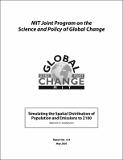| dc.contributor.author | Asadoorian, Malcolm O. | |
| dc.date.accessioned | 2005-06-10T15:13:37Z | |
| dc.date.available | 2005-06-10T15:13:37Z | |
| dc.date.issued | 2005-05 | |
| dc.identifier.issn | http://mit.edu/globalchange/www/abstracts.html#a123 | |
| dc.identifier.uri | http://hdl.handle.net/1721.1/18092 | |
| dc.description | Abstract in HTML and technical report in PDF available on the Massachusetts Institute of Technology Joint Program on the Science and Policy of Global Change website (http://mit.edu/globalchange/www/). | en |
| dc.description.abstract | Urbanization and economic development have important implications for many environmental processes including global climate change. Although there is evidence that urbanization depends endogenously on economic variables, long-term forecasts of the spatial distribution of population are often made exogenously and independent of economic conditions. A beta distribution for individual countries/regions is estimated to describe the geographical distribution of population using a 1° x 1° latitude-longitude global population data set. Cross-sectional country/regional data are then used to estimate an empirical relationship between parameters of the beta distribution and macroeconomic variables as they vary among countries/regions. This conditional beta distribution allows the simulation of a changing distribution of population, including the growth of urban areas, driven by economic forecasts until the year 2100. | en |
| dc.format.extent | 1051783 bytes | |
| dc.format.mimetype | application/pdf | |
| dc.language.iso | en_US | |
| dc.publisher | MIT Joint Program on the Science and Policy of Global Change | en |
| dc.relation.ispartofseries | ;Report no. 123 | |
| dc.subject | population distribution | en |
| dc.subject | spatial econometric | en |
| dc.subject | urbanization | en |
| dc.title | Simulating the Spatial Distribution of Population and Emissions to 2100 | en |
| dc.identifier.citation | Report no. 123 | en |
